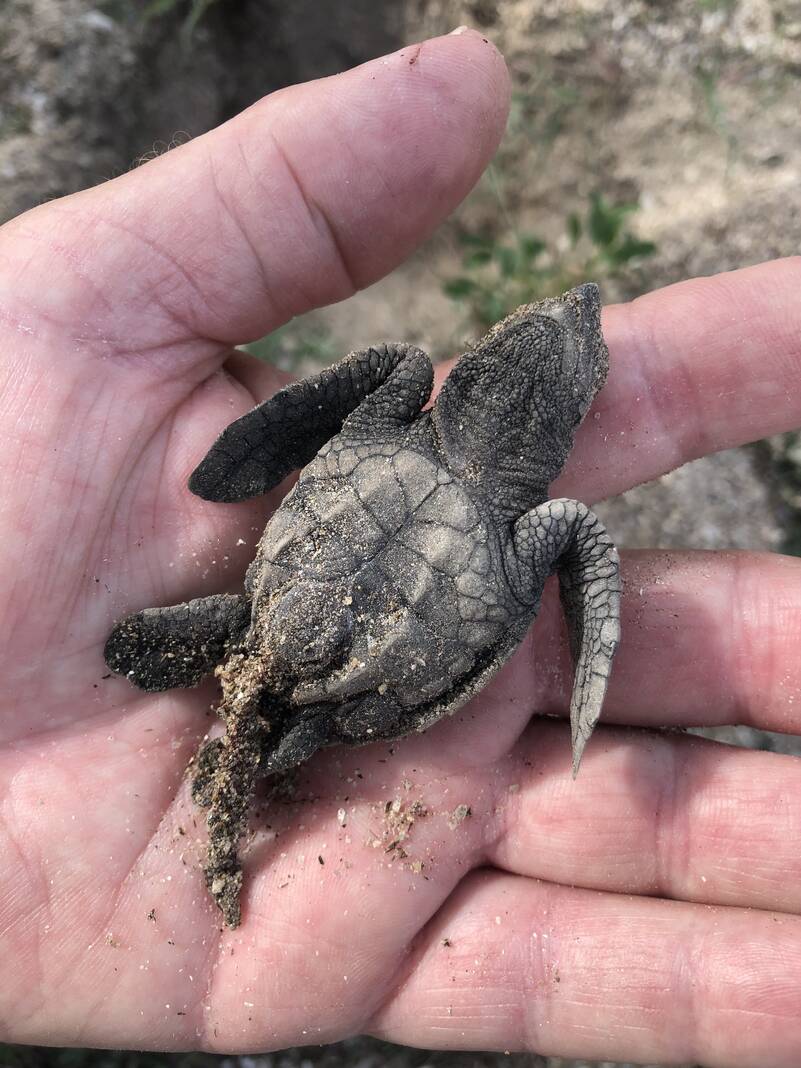Perhaps having assessed the price of beachfront property, a Kemp’s ridley sea turtle found an alternative, and instead of nesting on a white sand gulf beach, she found a spot inside Matagorda Bay.
And that’s so unusual, sea turtle experts say they’ve never seen it before now.
“This has never happened in modern times,” said Pamela Plotkin, director of the Texas Sea Grant Program at Texas A&M University and a sea turtle biologist. “Sea turtles typically nest on barrier island beaches in Texas, and so seeing a turtle nest on a beach inside any bay is rare. There are many miles of unpopulated bay shoreline along Texas’ coast, so it is possible that sea turtle nesting on these shores is more frequent and undetected.”

The drama began last week when maintenance workers from the Calhoun County Precinct 1 Commissioners Office were doing routine work picking up trash at Magnolia Beach, which consists of hard, crushed shell, not the light sand of gulf beaches.
Then they saw about 25 hatching sea turtles, heading in the wrong direction.
Zach Padron told Texas Sea Grant he and Jason Gonzalez knew hatching is a dangerous time for turtles due to predation so the pair decided to help. The turtle mom, of course, was long gone, having performed her part of nature’s bargain.
“I thought, ‘We better help them, because it’s a good ways to the water,’” Padron told Texas Sea Grant.
They contacted their boss, Commissioner David Hall, who alerted county marine extension agent and Texas Sea Grant agent RJ Shelly.
“When I got to the nest, it was a shallow depression about five inches, six inches deep, max,” Shelly said in a telephone interview Monday. “You could definitely see there were some eggs that had hatched around the edges.
“I had been on the phone with the director of Texas Sea Grant, she’s a turtle expert, Dr. Plotkin, and I took a picture of one of the hatchlings and sent it to her, and she said it looks like a Kemp’s ridley,” he added.
A second photo of the turtle’s belly confirmed it, he said. But the concern was the nest was just 10 feet away from a road, presenting a major problem for any little turtle who took a wrong turn.
“So then she talked me through how to excavate the nest, she said sometimes it helps, and sure enough, kinda of just using the fingertips real gently, I started moving a little sand aside and, whoa, there’s an egg, there’s another egg and then we start seeing sand moving and the little hatchlings were coming out of the shells actually in the process of hatching,” Shelly said. “We kind of repeated that process for about four hours until they were all hatched.”
Between the county workers and Shelly, around 40 to 45 hatchlings were taken down within 10 feet of the water and released.
The Kemp’s ridley sea turtle is a critically endangered species but it is making a strong comeback in the Gulf of Mexico.
While most of the Kemp’s ridley turtles nest along Mexico beaches, hundreds make the trip to Texas from Boca Chica beach to just north of Galveston to nest between April and July.
“Matagorda Bay is currently a vibrant healthy ecosystem with an abundance of sea turtles that live and feed there,” Plotkin said. “In the late 1800s there was a commercial sea turtle fishery operating there that decimated the sea turtles in the bay by the early 1900s. Signs of sea turtle recovery in Matagorda Bay are visible now and illustrate how reduced fishing pressure in concert with habitat restoration can save threatened and endangered species.”
This year, according to data provided by Padre Island National Seashore researchers, 238 Kemp’s ridley nests have been located along the Texas coast.
Of those, 13 were located on Boca Chica beach and another 59 were found on South Padre Island. The highest number of nests, 115, have been found along Padre Island National Seashore.
The farthest nests to the north were two found on the Bolivar peninsula just up the coast from Galveston Island, which has recorded four nests this season.



